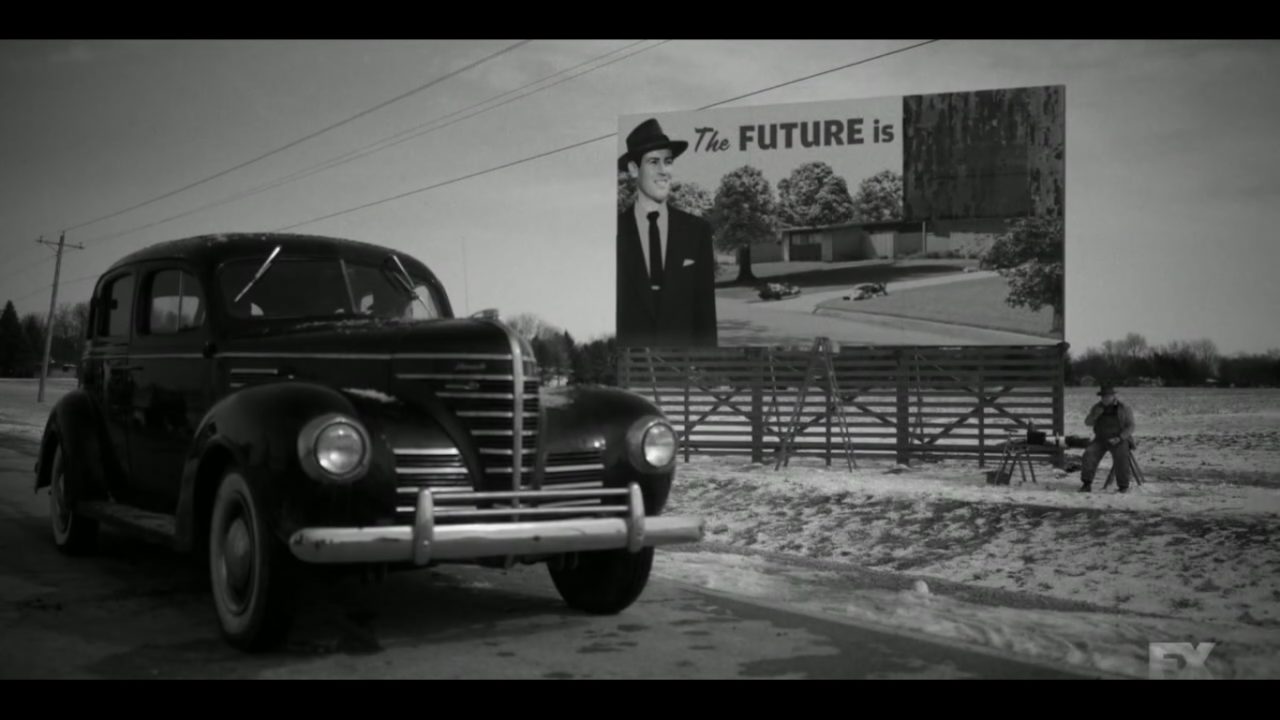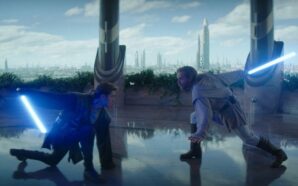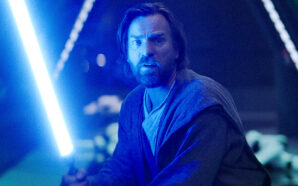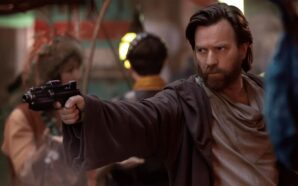Fargo’s fourth season is a bit of a mess. It’s always enjoyable but often unfocused, bouncing between storylines and ideas that have the potential to be fascinating but never quite gain momentum. The extended 11-episode season had some episodes in the middle of the season edited and reshuffled into a different form than the scripts, with two episodes suddenly becoming three, and you can tell. Storylines aren’t balanced and characters move in holding patterns until the season’s final act, which feels fairly unsatisfying. It’s still well-written television – this is Fargo after all – but it’s by far the weakest season.
Yet one episode of this lacking season stands proud above all others, above every episode of all four seasons, in fact. East/West is Fargo at its most ambiguous but most focused too. A totally unique episode of the show but one intrinsically tied to the mythos and very nature of the series. Feeling similar in style to an episode of The Leftovers, East/West is deeply thematic and standalone yet fits perfectly into its serialised narrative, becoming the show’s true masterpiece in the midst of its shakiest season.
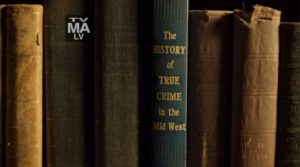 East/West begins with both a new element added to the quirky formula of Fargo and a recurring one, setting the stage for the push-and-pull conflict between warring elements that’ll continue throughout the episode. Uniquely, East/West opens with a Bertrand Russell quote, “Life is nothing but a competition to be the criminal rather than the victim”, which comments on the cyclical nature of the gangsters throughout the season, their desire to be the most powerful, and Satchel’s attempt to escape from that life, which the episode will ultimately be about. We then push into the pages of “The History of True Crime in the Midwest”, a returning device from seasons past that’ll go on to represent something new.
East/West begins with both a new element added to the quirky formula of Fargo and a recurring one, setting the stage for the push-and-pull conflict between warring elements that’ll continue throughout the episode. Uniquely, East/West opens with a Bertrand Russell quote, “Life is nothing but a competition to be the criminal rather than the victim”, which comments on the cyclical nature of the gangsters throughout the season, their desire to be the most powerful, and Satchel’s attempt to escape from that life, which the episode will ultimately be about. We then push into the pages of “The History of True Crime in the Midwest”, a returning device from seasons past that’ll go on to represent something new.
The opening sequence, following Omie seek out Calamita in Liberal, Kansas is disconnected from the main action of the episode until it links up towards the end but it works perfectly to set the tone. Not only does it feature a classic Fargo animal allegory – Noah Hawley fashioning himself as a modern-day Aesop or Dr. Seuss – and give the supporting characters some added time to shine, but Omie also visits the “Pancake Hub of the Universe” and the birthplace of the discoverer of Pluto, which are details that are at first baffling but are later revealed to be at the core of the episode. East/West balances the grounded, gritty 1950’s world of racism and trauma with the galactic and the cosmic. Forces more powerful than any character in the series.
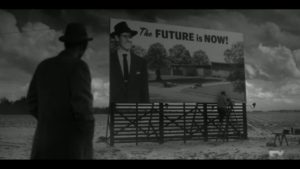 The Future is Now! Rabbi Milligan is both engrossed and annoyed by the billboard philosophy he spies by the side of the road while escaping Kansas City with the young Satchel Cannon. Milligan has been a man without a future his whole life. He’s been locked in this game – this cycle – of warring factions who gain power before being usurped by the next gang trying to gain some control over their lives. Having killed his abusive father and swapped sides to the Italians, Milligan belongs to no clan and his future is forever uncertain. Every time he leaves his ward, Satchel, he says if he doesn’t return, he’s either dead or in jail. Like Goldilocks, a story told a few times this season, with both bears and witches in roles, he doesn’t belong anywhere. But as the episode progresses, he finally begins to think otherwise and dares to imagine a new life for himself and Satchel.
The Future is Now! Rabbi Milligan is both engrossed and annoyed by the billboard philosophy he spies by the side of the road while escaping Kansas City with the young Satchel Cannon. Milligan has been a man without a future his whole life. He’s been locked in this game – this cycle – of warring factions who gain power before being usurped by the next gang trying to gain some control over their lives. Having killed his abusive father and swapped sides to the Italians, Milligan belongs to no clan and his future is forever uncertain. Every time he leaves his ward, Satchel, he says if he doesn’t return, he’s either dead or in jail. Like Goldilocks, a story told a few times this season, with both bears and witches in roles, he doesn’t belong anywhere. But as the episode progresses, he finally begins to think otherwise and dares to imagine a new life for himself and Satchel.
If Milligan can only escape the pursuing Italians, he could have a future with Satchel, truly becoming his guardian and freeing the boy of living the same life he himself has led. He can lift his father’s curse, both the metaphorical one of being born into a family of crime and the literal one spat at him with his father’s dying breath. Inspired by the billboard, finally deciding that this dream-like future is available to him now, he confidently tells a hotel receptionist he’ll be right back instead of his usual uncertainty over jail or death, and goes to secretly buy Satchel some sweets. Of course, this is when a freak tornado comes out of nowhere and kills him.
 The tornado is the perfect Fargo moment of chance scuppering a plan in the most heartbreaking but hilarious of ways. As the wise Doctor Senator states earlier in the season, “God created tornadoes to remind us we have no control”. The tornado doesn’t care about sides in this war; it kills three people from three different crime families, in fact. It shows how all these factions will wind up dead sooner or later and their fight for control is worthless. Just like Swanee in the previous episode, the last thing Milligan does before his death is go to buy sweets. In this brutal world, it’s just as much innocence that kills him as a tornado. The scene is certainly brutal and a gut punch but also oddly beautiful at the same time. The episode overall is stunning but that sequence is an incredible technical feat, particularly when it comes to the cinematography and music.
The tornado is the perfect Fargo moment of chance scuppering a plan in the most heartbreaking but hilarious of ways. As the wise Doctor Senator states earlier in the season, “God created tornadoes to remind us we have no control”. The tornado doesn’t care about sides in this war; it kills three people from three different crime families, in fact. It shows how all these factions will wind up dead sooner or later and their fight for control is worthless. Just like Swanee in the previous episode, the last thing Milligan does before his death is go to buy sweets. In this brutal world, it’s just as much innocence that kills him as a tornado. The scene is certainly brutal and a gut punch but also oddly beautiful at the same time. The episode overall is stunning but that sequence is an incredible technical feat, particularly when it comes to the cinematography and music.
Not only is the tornado a “Mike Yanagita” element in the show – a truth-is-stranger-than-fiction event that’s so outlandish it adds a ‘you can’t make this stuff up’ quality to this “true story” – but it’s also one of many references to The Wizard of Oz. The episode is shot in black-and-white and only transitions to colour after the tornado scene. The setting is Kansas. Satchel finds a small dog similar to Toto. And I’m sure there are plenty more details apparent to fans of the film, of which I’m not one. This perfectly fits into the idea that the fourth season is almost an American fairytale, an origin story of sorts for the crime stories of Fargo with a mythic twist. Not only that, but this episode, for as crazy as it is, is also the one that feels the most Coen Brothers-esque. The character interactions and dialogue are of that rich quality and Hawley once again proves himself an excellent mimic of their work while also adding his own flavour.
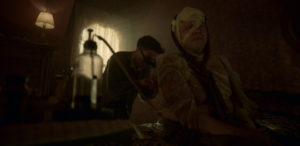 While laying low in Kansas, Milligan and Satchel stay at The Barton Arms, a place of metaphysical purpose and symbolism. The building is split down the middle and residents either stay in the east side or the west side which are operated by different sisters (another Wizard of Oz connection) with different rules and taste for furnishings. In truth it’s a place of danger and temptation, a trap, representing the life laid out before Satchel, in both meanings of “before”: laid out in front of him and in the preceding years. An embodiment of the violent cycle he needs to escape. The Barton Arms is host to the ghosts of Fargo past with actors from the season premiere seemingly playing new roles. Rabbi’s paedophile father, Yiddles Milligan, played by Ira Amyx, takes the form of “Bandaged Man”, who tries to lure Satchel into his room. Again played by Andrew Rothenberg, the Jewish mob boss Liev Moskowitz is now Pastor Roanoke, a purposeful if not unsubtle name. Although it’s certainly better than Dr. Harvard.
While laying low in Kansas, Milligan and Satchel stay at The Barton Arms, a place of metaphysical purpose and symbolism. The building is split down the middle and residents either stay in the east side or the west side which are operated by different sisters (another Wizard of Oz connection) with different rules and taste for furnishings. In truth it’s a place of danger and temptation, a trap, representing the life laid out before Satchel, in both meanings of “before”: laid out in front of him and in the preceding years. An embodiment of the violent cycle he needs to escape. The Barton Arms is host to the ghosts of Fargo past with actors from the season premiere seemingly playing new roles. Rabbi’s paedophile father, Yiddles Milligan, played by Ira Amyx, takes the form of “Bandaged Man”, who tries to lure Satchel into his room. Again played by Andrew Rothenberg, the Jewish mob boss Liev Moskowitz is now Pastor Roanoke, a purposeful if not unsubtle name. Although it’s certainly better than Dr. Harvard.
These ghosts, for lack of a better word, wish to keep Satchel in the cycle of violence they died in, and even the other residents wish him harm. The old man who seems to be from another era has a young girl with him who he claims is his niece, although it all feels very Lolita. Even the two sisters could easily transcend their referential nature to The Wizard of Oz and be actual witches. A sign outside the property tells the story of “The Mellon Mounds” and how an infamous family lured people to that spot and killed them with a hammer. The ultimate fate of the family was never discovered and it’s not hard to believe their evil lives on. The Barton Arms and its occupants, whether supernatural or wholly tangible, wish to do Satchel harm but the boy finally listens to Milligan’s lessons once he’s alone and backs away. He refuses to be swallowed up by the evil and leaves on a better path.
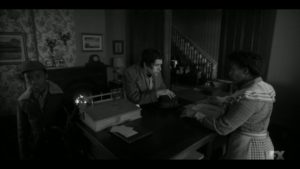 I’m surprised that The Barton Arms didn’t disappear at the end of the episode, fading away once its role in the story, specifically Satchel’s story, was complete. It’s almost supernatural, like a negative version of the bowling alley from Season 3. Snowman, the entity that haunts and/or protects the Smutny family, appears throughout the season and almost feels like a misdirection. We place all our focus on that being this season’s flirtation with the supernatural, following UFOs, the Wandering Jew, and maybe the Devil himself in seasons past, that The Barton Arms sneaks under the radar as a ghostly twist. It reminded me of the Black Lodge from Twin Peaks, especially with the space connection to Pluto. And the final shot of a person standing alone, thinking of their future and past, on the cusp of possible change, feels very Mad Men. Maybe this is my favourite episode of Fargo because it so well combines my three favourite TV series: The Leftovers, Twin Peaks, and Mad Men.
I’m surprised that The Barton Arms didn’t disappear at the end of the episode, fading away once its role in the story, specifically Satchel’s story, was complete. It’s almost supernatural, like a negative version of the bowling alley from Season 3. Snowman, the entity that haunts and/or protects the Smutny family, appears throughout the season and almost feels like a misdirection. We place all our focus on that being this season’s flirtation with the supernatural, following UFOs, the Wandering Jew, and maybe the Devil himself in seasons past, that The Barton Arms sneaks under the radar as a ghostly twist. It reminded me of the Black Lodge from Twin Peaks, especially with the space connection to Pluto. And the final shot of a person standing alone, thinking of their future and past, on the cusp of possible change, feels very Mad Men. Maybe this is my favourite episode of Fargo because it so well combines my three favourite TV series: The Leftovers, Twin Peaks, and Mad Men.
The episode begins by zooming into a history book and I see the scenes shot in black-and-white to be an historical record, something written, literally in the book, but the scenes in colour are the future, out-of-the-book, unwritten. We know from the finale that Satchel will become Mike Milligan, a man with his eyes on the top but caught in middle management. That’s even more depressing after seeing this episode but he did escape the immediate cycle. He was gifted vital life lessons and that saved him from The Barton Arms and what it symbolised. The one thing left standing after the tornado is the billboard, shining in full colour and in pristine condition. The Future is Now. Satchel, as Mike Milligan, will go on to embody the future of crime himself in the second season as he wipes away the Gerhardt family, a family not dissimilar to the one he came from and overcame.
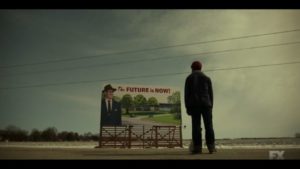 There’s so much more that can be discussed and decrypted from this thematically rich and symbolic episode, from the guests at The Barton Arms, Milligan’s hunt for his missing money, and the multitude of Coen Brothers references found throughout the hour, of which the Barton Arms is one, if not two. While the fourth season is my least favourite, though fascinating in its own way, East/West is an episode, the episode, I’ll rewatch again and again, and I’m sure I’ll find new things to love and ponder each time. But the episode not only works on an intellectual, openly pretentious level but on an emotional level too. With the huge cast and cables-behind-the-TV tangle of storylines, Season 4 felt cold and impersonal. I could never connect with the characters other than Rabbi and Satchel, particularly in East/West which shut out the background noise and told a focused Fargo tale in an ingenious way, becoming the true masterpiece instalment of the series.
There’s so much more that can be discussed and decrypted from this thematically rich and symbolic episode, from the guests at The Barton Arms, Milligan’s hunt for his missing money, and the multitude of Coen Brothers references found throughout the hour, of which the Barton Arms is one, if not two. While the fourth season is my least favourite, though fascinating in its own way, East/West is an episode, the episode, I’ll rewatch again and again, and I’m sure I’ll find new things to love and ponder each time. But the episode not only works on an intellectual, openly pretentious level but on an emotional level too. With the huge cast and cables-behind-the-TV tangle of storylines, Season 4 felt cold and impersonal. I could never connect with the characters other than Rabbi and Satchel, particularly in East/West which shut out the background noise and told a focused Fargo tale in an ingenious way, becoming the true masterpiece instalment of the series.
What are your thoughts on East/West? Was it the highlight of the fourth season for you? Let me know in the comments and be sure to geek out with me about TV, movies and video-games on Twitter @kylebrrtt.




